The Nursing Sisters of Canada
This publication is available upon request in alternate formats.
PDF Version
Introduction
This tribute to Canadian Nursing Sisters tells of these brave and dedicated women. Their story is one of humour as well as anguish. It is a story of unyielding women who braved all the hardships of war to do their duty and care for their patients, and of those who nursed the casualties left in the wake of war.
Military nursing had its beginnings in the Crimean War, although the tradition of alleviating the sufferings of soldiers is an old one. The organizing of battle nursing and the dispatch of women as nurses, begun by Florence Nightingale for the British, soon found its way to Canada.
It was in 1885 when Canada’s Nursing Sisters first took to the field, providing care to the Canadian troops sent to put down the North-West Rebellion. From the North-West Rebellion onward, Nursing Sisters joined every military force sent out by Canada, from the South African War to the Korean War. Although the nurses in Canada’s military are no longer referred to as Nursing Sisters, their contributions have continued into the activities and missions of the present-day Canadian Armed Forces. Over the years, the devotion and efficiency of Canada’s military nurses have earned them a very high reputation among the troops with whom they served and to whom they ministered.
The Early Years
The history of the Canadian Nursing Sisters spans almost the entire history of Canada as a country. During the Crimean War and American Civil War, nurses had been extremely effective in providing treatment and comfort not only to battlefield casualties, but to the scores of individuals felled by accidents and infectious disease.
In the North-West Rebellion of 1885, Canadian nurses performed formal military service for the first time. In April of that year, orders were issued from Ottawa requesting that a medical and surgical department be organized for service in the Northwest.
At first, the nursing needs identified were for home duties such as making bandages and preparing medicinal and food supplies. Members of societies, such as the Red Cross, were advised to volunteer as nurses should the need arise. It soon became apparent that more direct participation by nurses was needed if the military was to provide effective medical field treatment. A total of seven nurses, under the direction of Reverend Mother Hanna Grier Coome, served in Moose Jaw and Saskatoon, Saskatchewan. Although their tour of duty lasted only four weeks, these women proved that nursing could, and should in the future, play a vital role in providing treatment to wounded soldiers.
The early links between nursing and the military were not restricted to wartime situations. With the discovery of gold in the Yukon in 1898, a contingent of Royal Canadian Dragoons was sent to the Klondike to reinforce the Northwest Mounted Police. Included with this contingent were four members of the Victorian Order of Nurses. These nurses not only fulfilled their duties in the Klondike, but proved invaluable to the party as it encountered many incidents that required medical treatment.
Following the formation of the Canadian Army Medical Department in June of 1899, the Canadian Army Nursing Service was created and four Canadian nurses were dispatched along with the volunteer force of 1,000 other Canadians to South Africa. They were granted the relative rank, pay and allowances of an army lieutenant. Before the war was over on May 31, 1902, eight Canadian Nursing Sisters and more than 7,000 Canadian soldiers had volunteered for service in South Africa. Along with the usual battlefield-inflicted injuries, the ravages of disease compounded the horrors of war. The hot climate and a lack of sanitary facilities or adequate antiseptic conditions led to outbreaks of disease and infection. The statistics tell the story; before the first significant Canadian battle at Paardeburg 10 per cent of Canada's soldiers were unable to fight because of disease brought on by heat and poor sanitation. In fact, out of the 20,000 total British Empire deaths attributed to the conflict, only 6,000 were actual battle-related casualties.
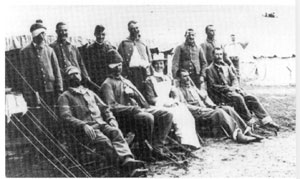
Miss Minnie Affleck, Nursing Sister (N/S), 1st Canadian Contingent, the South African War with wounded soldiers, circa 1900.
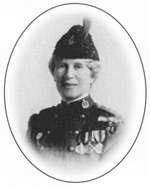
Georgina Fane Pope.
The first Canadian to receive the Royal Red Cross.
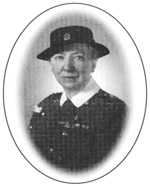
Elizabeth L. Smellie.
The first female colonel in the Canadian army.
The First World War
When Britain declared war on the German Empire, Canada was automatically compelled to fight alongside Britain in the Great War of 1914-18. At the beginning of the war there were five Permanent Force nurses and 57 listed in reserve. By 1917, the Canadian Army Nursing Service included 2,030 nurses (1,886 overseas) with 203 on reserve. In total, more than 2,800 Canadian nurses volunteered their services. Because of their blue dresses and white veils they were nicknamed the "bluebirds," and for their courage and compassion they received the admiration of many soldiers.
The First World War saw great courage and sacrifice on the part of many nurses, such as Britain’s Edith Cavell. She was a nurse who remained in Brussels, Belgium, after the Germans occupied the city early in the war, tending to wounded soldiers of all countries. However, in addition to this work, Cavell helped captured British, French and Belgian soldiers escape to the neutral Netherlands (where most would eventually make it to England). When her activities were discovered, she was executed as a spy, but not before she helped about 200 men escape the Germans.
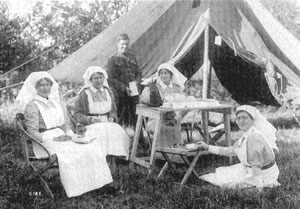
Nurses at No. 3 Casualty Clearing Station, July 1916
In many ways, the First World War was a time of great change and innovation in the field of military medical services. At first, medical units were set up in hospitals. However, the eventual establishment of Casualty Clearing Stations provided faster and more effective treatment to the injured at the front line.
The Casualty Clearing Station was an advance unit, situated close to the front line, where ambulances could deliver the wounded to be assessed, treated or evacuated to one of the many hospitals. The early stage assessment and treatment available at these units proved very effective in the efficient handling of large groups of battle injuries that occurred at the front. At the same time, however, the proximity to the fighting exposed the Nursing Sisters to the horrors and dangers particular to the front. The advance areas were often under attack from air raids and shell fire, frequently placing the lives of the sisters in danger. As well, the Casualty Clearing Stations were often plagued with the same aggravations of front line life; many nurses reported that rats and fleas were constant plagues.
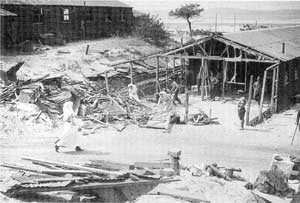
Canadian Nursing Sisters working amongst the 1st Canadian General Hospital, Étaples, which was bombed by the Germans. Three Nursing Sisters killed, June 1918.
The dangers of working in an advance area were not restricted to the land operations. One of the innovations of the First World War Medical Services was the introduction of the hospital ship. These ships were also subject to the dangers of enemy attack. On the night of June 27, 1918, the Canadian hospital ship Llandovery Castle was torpedoed by a German U-boat and 234 people lost their lives, including all 14 sisters on board.
In France, as well as Africa and the Mediterranean, the nurses had to deal not only with an exhausting workload, but often under extremely primitive working conditions and desperate climatic extremes. This was the pre-antibiotics age and, as was the case during the South African conflict, the ranks of the injured were swelled by infection and outbreaks of diseases such as meningitis. In spite of these challenges, the Canadian Nursing Sisters were able to provide comfort to the sick and injured.
A total of more than 2,800 Nursing Sisters served in the Canadian Army Medical Corps and 2,504 of those served overseas in England, France and the Eastern Mediterranean at Gallipoli, Alexandria and Salonika. By the end of the First World War, approximately 45 Nursing Sisters had given their lives, dying from enemy attacks including the bombing of a hospital and the sinking of a hospital ship, or from disease. The beautiful Nursing Sisters’ Memorial in the Hall of Honour in the Parliament Buildings in Ottawa is a loving tribute to their service, sacrifice and heroism.
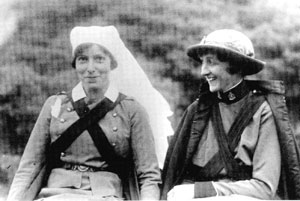
Canadian Nursing Sisters, May 1917.
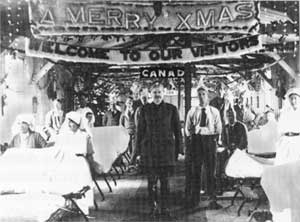
Nursing Sister Christine Macdonald (second from left). Christmas in a field hospital in France, with US Medical Unit as guests of Canadian Army Medical Corps.
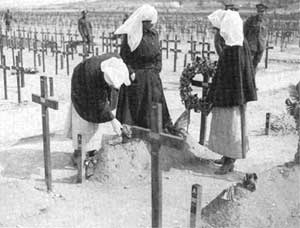
Funeral of Nursing Sister (N/S) Margaret Lowe, of Binscarth, Manitoba, who died of wounds received during raid by Germans at Étaples, France, May 1918.
The Second World War
After Germany’s invasion of Poland in September 1939, Canada again found itself thrust into a world conflict and again the Nursing Sisters answered the call of duty. This time, however, the nursing service was expanded to all three branches of the military: navy, army and air force. Each branch had its own distinctive uniform and working dress, while all wore the Nursing Sisters’ white veil. They were respectfully addressed as “Sister” or “Ma’am” because they were all commissioned officers. With the average age of 25, by war's end 4,480 Nursing Sisters had enlisted, including: 3,656 with the Royal Canadian Army Medical Corps, 481 with the Royal Canadian Air Force Medical Branch, and 343 with the Royal Canadian Naval Medical Service.
The army sisters, after training in Canada, were the first to go overseas, where they joined units which had preceded them to the United Kingdom. With the soldiers going overseas, the sisters travelled by ship in large convoys, running the perilous gauntlet of German submarine action in the North Atlantic. Upon arrival in England, they worked in the Royal Canadian Army Medical Corps’ hospitals at Taplow, Bramshott and Basingstoke. To illustrate the demands of their work, following the Dieppe raid, the hospital at Basingstoke received more than 600 casualties and in one 19 1/2 hour period, 98 operations were performed. The surgical staff took only a few minutes’ break to rest between operations.
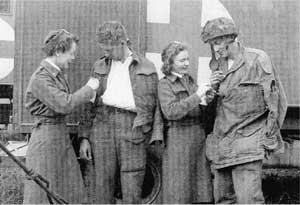
I. Ogilvie and Paratrooper H.W. Kivinen after arrival of Princess Mary Royal Air Force Nursing Service June 16, 1944.
After three years in England, Nursing Sisters were sent into action on the continent. Donning battle dress, steel helmets and backpacks, No. 1 Canadian General Hospital arrived in Sicily, the first women to land in the Eighth Army area. Almost all hospital units deployed to the continent were initially set up under canvas. Later, they were moved into abandoned or bombed-out buildings. As in the First World War, Nursing Sisters faced many dangers and obstacles in trying to provide medical care in the battle zone. During an air raid on Catania, Sicily, on September 2, 1943, an anti-aircraft shell fell on No. 5 Canadian General Hospital and 12 Nursing Sisters were wounded.
The second unit was deployed to El Arrouch, Algeria. Soon after, two more units were dispatched to Italy. En route, the S.S. Santa Elena, which was carrying No. 14 Canadian General Hospital, was attacked, forcing all to take to the lifeboats. Fortunately, there was no loss of life.
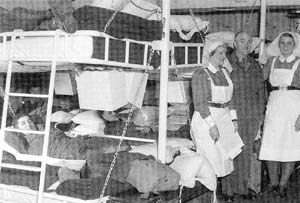
Patients and Nursing Sisters in ward aboard No. 2 Canadian General Hospital Ship Letitia. Liverpool, England, November 24, 1944.
As the medical units followed the front north through Italy, they were frequently within range of enemy guns and subject to shelling. Enemy action kept Nursing Sisters extremely busy. For example, in the Ortona salient, the No. 4 Casualty Clearing Station would receive more than 2,000 patients in December 1943, 760 of whom were surgical. After the fall of Rome, there was a comparatively light period of activity, and the sisters settled into routine hospital life caring for Canadian patients and German prisoners alike. As the Italian campaign drew to an end for the Canadians, three medical units moved on to France; the others were disbanded and the sisters posted to other units.
Thirteen days after D-Day, June 6, 1944, the first two Canadian Nursing Sisters, with No. 2 Royal Canadian Air Force Mobile Field Hospital landed in Normandy at Bernières-sur-Mer. They followed others assigned to Nos. 2, 3 and 6 Casualty Clearing Stations. The Stations were set up in the Caen area. By mid-July, Nos. 7, 8, and 10 Canadian General Hospitals were established west of Bayeux.
As the front moved across northern France and into Belgium, in pursuit of the fleeing German armies, the medical units moved with them. Antwerp, which had been captured, was the target of the dreaded German V-2 rockets, and with the Battle of the Scheldt raging to free the Channel ports, the units moved to Nijmegen. The casualties were heavy, 3,934 in four weeks. Fortunately, the end was soon near. The Spring offensive was on and the German Army was driven across the Rhine, where surrender was imminent.
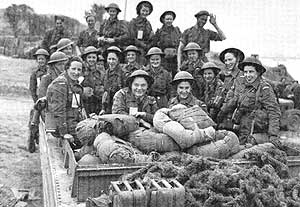
Nursing Sisters of No. 10 Canadian General Hospital, RCAMC landing at Arromanches, France, July 23, 1944.
With the end of the war in Europe, the medical units gradually disbanded. Some of the Nursing Sisters as well as other personnel stayed on with the Army of Occupation to care for both military and civilian prisoners of war being released from the horrors of the camps.
Two Canadian Nursing Sisters, Kathleen G. Christie and Anna May Waters, had accompanied the force sent to Hong Kong. Later, when the garrison fell, they were taken prisoner by the Japanese. These brave women stayed with the wounded Canadian men, working under atrocious conditions, until they were finally forced into a civilian internment camp. After two years in captivity, they were repatriated to Canada.
During the Battle of the Atlantic, which lasted for the duration of the war, the Canadian Navy had two hospital ships, the Letitia and the Lady Nelson. Both were staffed by army sisters. The navy sisters served on naval bases on both coasts of Canada, in Newfoundland, and at HMCS Niobe, Scotland. The only Canadian nurse to die due to enemy action during the Second World War was a navy sister, Sub-Lt. Agnes Wilkie. Despite the heroic efforts of her companion, Sub-Lt. (dietitian) Margaret Brooke, Sister Wilkie died following more than two hours of struggle to hold out in a life boat, after the sinking of the SS Caribou on October 13, 1942, in the Cabot Strait off Newfoundland. Margaret Brooke was awarded membership in the Order of the British Empire, the only Nursing Sister to receive this honour.
The Nursing Service of the Royal Canadian Air Force was authorized in November 1940. More than 100 station hospitals were built and the Nursing Sisters were more and more in demand. Some of them were trained for evacuation by air, 12 served in Newfoundland to participate in air-sea rescue missions and 66 served overseas. By the end of the Second World War, 3,649 Nursing Sisters had served in the Army, 481 in the Air Force and 343 in the Navy.
No account of military service in the Second World War would be complete without mention of the contribution made by the four special branches of the nursing service—the Physiotherapists, Occupational Therapists, Dietitians and Home Sisters. Also, the sisters who served on the hospital trains returning the wounded to destinations across Canada.
The end of the Second World War brought the closure of military and station hospitals across Canada. A total of 80 nurses, 30 RCAMC, 30 RCAF and 20 RCN sisters joined the permanent force and served at military establishments across the country; many more staffed the Department of Veterans Affairs’ hospitals to care for hundreds of returning Veterans.
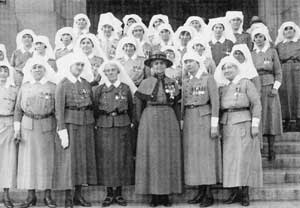
Nursing Sisters attending the unveiling in Ottawa on August 24, 1926, of a memorial to Canadian Nurses who gave their lives in the First World War. Included in the photo are Dame Maud McCarthy, G.B.E., R.R.C. Matron-in-Chief of Territorial Army Nursing Service (N.S.), Great Britain, with Margaret C. MacDonald, Matron-in-Chief, CAMC, N.S., on her left.
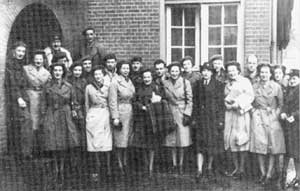
No. 6 Casualty Clearing Station personnel leaving Holland on Christmas Day, 1945. Many lifelong friendships were maintained through the Nursing Sisters’ Association.
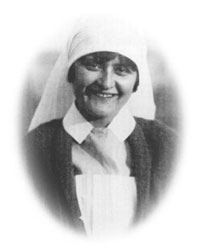
Canadian Nursing Sister wearing her winter jumper, – merry and bright – somewhere in France. December 1917.
After the Second World War
Nursing Sisters have continued to serve with the Armed Forces since the end of the Second World War. During the United Nations Operations in Korea, RCAMC Nursing Sisters served in Japan and Korea.
In Korea, 60 Canadian nurses were again faced with providing medical services in a combat zone. They also faced the daunting challenge of fighting battle-inflicted injuries, and infectious disease. When the ceasefire came into effect in 1953, the sisters worked with the newly-released prisoners of war, helping to restore their physical health.
RCAF Sisters qualified as Flight Nurses, flew air evacuation with casualties to Canada. Others served on the Air Ambulance in Canada. Another specialty was the formation of a para-rescue service with five RCAF volunteering, four of whom received the Para-rescue Badge.
Canada’s commitment to NATO saw Canadian nurses serving in Europe with the RCAMC in Soest, Germany, and the RCAF Sisters at fighter bases in Germany, as well as France.
Today, Nursing Officers (as Nursing Sisters are now known) serve with the Canadian Armed Forces Medical Service, both at home and abroad. In Canada, these professionals do things like serving in civilian hospitals or military clinics, tending to the men and women in the Canadian Armed Forces and their families. When serving in the field, overseas, Nursing Officers often encounter the same hazards and conditions as the troops with whom they serve. In recent years, they have served in the Canadian Armed Forces’ efforts in the Gulf War, Bosnia-Herzegovina, Rwanda, Somalia and Afghanistan where they have upheld the proud legacy of the dedicated service of nurses in Canada’s Armed Forces.
The Canadians who have served as Nursing Sisters have achieved and sacrificed much in their efforts to support our country’s efforts to bring peace and freedom to others in the world. These women were among the more than 1.6 million Canadians who served in uniform during the conflicts of the 20th century. More than 110,000 Canadians gave their lives in these wars. Canada recognizes the sacrifices and achievements of all the Canadians, like those who served as Nursing Sisters, who accomplished so much and left such a lasting legacy of peace.
Perhaps the most fitting statement regarding the service of the Nursing Sisters in Canada comes from the last paragraph of Col. G. W. Nicholson’s book, Canada’s Nursing Sisters:
“In whatever conflict Canadians have been called on to bear arms, in the last hundred years, the medical services of Canada have earned a high reputation for the skill and devotion with which they played their special part. It is a reputation that has not suffered as they carried out their continuous function in time of peace. Canadian Nursing Sisters are justifiably proud to have borne their share alike with officers and men in the great contribution made by the medical services. Of these dedicated women it may be said “They served equally.”
Nursing Sisters Who Lost Their Lives in the First and Second World Wars
Nursing Sisters—First World War
- 1915
- 1916
- 1917
- 1918
- N/S ALPAUGH, Agnes Estelle, CAMC
- N/S ALPORT (Roberts), Jean Ogilvie, 4 General Hospital
- N/S BAKER, Miriam Eastman, 15 General Hospital
- N/S BALDWIN, Dorothy Mary Yarwood, 3 Stationary Hospital
- N/S BARTLETT, Bertha, Newfoundland Voluntary Aid Detachment
- N/S CAMPBELL, Christina, 5 General Hospital
- N/S DAGG, Ainslie St. Clair, 15 General Hospital
- N/S DAVIS, Lena A., 4 General Hospital
- N/S DOUGLAS, Carola Josephine, CAMC H.S.
- N/S DUSSAULT, Alexina, CAMC H.S.
- N/S FOLLETTE, Minnie Asenath, CAMC H.S.
- N/S FORNERI, Agnes Florien, 8 General Hospital
- N/S FORTESCUE, Margaret Jane, CAMC H.S.
- Matron FRASER, Margaret Marjory, CAMC H.S.
- N/S FREDERICKSON, Christine, CAMC
- N/S GALLAHER, Minnie Katherine, CAMC H.S.
- N/S GREEN, Matilda Ethel, 7 General Hospital
- N/S HENNAN, Victoria Belle, 9 General Hospital
- N/S HUNT, Myrtle Margaret, CAMC
- N/S JARVIS, Jessie Agnes, CAMC
- N/S JENNER, Lenna Mae, CAMC
- N/S KEALY, Ida Lilian, 1 General Hospital
- N/S LOWE, Margaret, 1 General Hospital
- N/S MCDIARMID, Jessie Mabel, 5 General Hospital
- N/S MACDONALD, Katherine Maud, 1 General Hospital
- N/S MACEACHEN, Rebecca Helen, CAMC
- N/S MCKAY, Evelyn Verrall, 3 General Hospital
- N/S MCKENZIE, Mary Agnes, CAMC H.S.
- N/S MCLEAN, Rena, RRC 2 Stationary Hospital
- N/S MACPHERSON, Agnes, RRC 3 Stationary Hospital
- N/S MELLETT, Henrietta, 15 General Hospital
- N/S PRINGLE, Eden Lyal, 3 Stationary Hospital
- N/S ROGERS, Nellie Grace, CAMC
- N/S ROSS, Ada Janet, 1 General Hospital
- N/S SAMPSON, Mary Belle, CAMC H.S.
- N/S SARE, Gladys Irene, CAMC H.S.
- N/S STAMERS, Anna Irene, CAMC H.S.
- N/S TEMPLEMAN, Jean, CAMC H.S.
- N/S TRUSDALE, Alice L., CAMC
- N/S TWIST, Dorothy Pearson, Canadian Military V.A.D.
- N/S WAKE, Gladys Maude Mary, 1 General Hospital
- N/S WHITELY, Anna Elizabeth, 10 Stationary Hospital
- 1919
- N/S BAKER, Margaret Elisa, CAMC
- N/S CHAMPAGNE, Ernestine, 8 General Hospital
- N/S DONALDSON (Petty), Gertrude, 1 General Hospital
- N/S GRANT, Grace Mabel, CAMC
- N/S KING, Jessie Nelson, 1 General Hospital
- N/S MCDOUGAL, Agnes, 10 Stationary Hospital
- N/S MCINTOSH, Rebecca, 9 General Hospital
- N/S MACLEOD, Margaret Christine, 2 General Hospital
- 1920
- 1921
- 1922
Nursing Sisters—Second World War
- 1940
- 1941
- 1942
- 1943
- 1944
- 1945
- 1946
- 1947
Legend
- N/S - Nursing Sister
- Lt. - Lieutenant
- H.S. - Hospital Services Group
© Her Majesty the Queen in Right of Canada represented by the Minister of Veterans Affairs, 2005. Catalogue No. V32-146/2005 ISBN 0-662-69038-9
Photographs courtesy of Library and Archives Canada.
- Date modified: